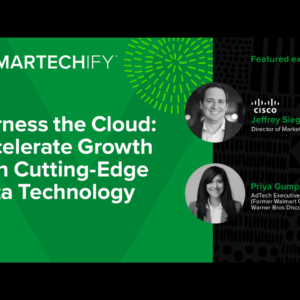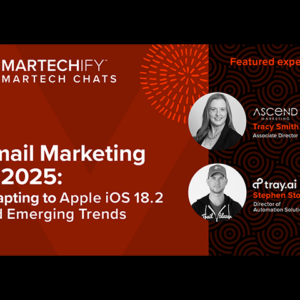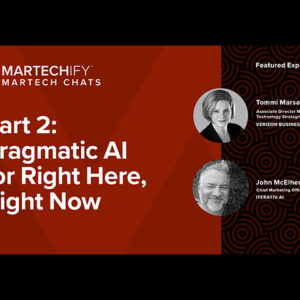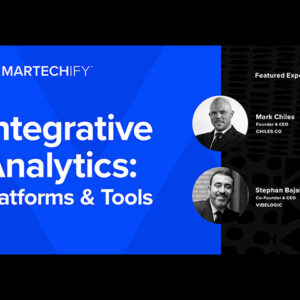Integrative Analytics:
Platforms & Tools
April 19, 2024—This lively and insight-packed session, moderated by Rich Herbst of Ascend Marketing, featured two of today’s leading experts in integrative analytics, Mark Chiles of Chiles Co and Stephan Bajaio of VibeLogic.
If you missed the event—or want a refresher of the discussion—read the summary below for the highlights.
Featured experts
Meet the experts
Founder & CEO, Chiles Co.
With over two decades of leadership in technological innovation and digital strategy, Mark Chiles is the Founder and CEO of Chiles Co, where he guides businesses towards digital excellence. His expertise spans technology planning, digital transformation, product development, and operational management. Prior to founding Chiles Co, he was the Chief Digital Officer at Hart Energy, responsible for digital strategy, software engineering projects, and managing the digital product business. He also founded Overwrite Media, a media company covering the digital ecosystem, and Tech Guy Fishing, his YouTube channel focused on fishing. As an author on Forbes.com and a former member of the Forbes Technology Council, Mark has had the opportunity to share his insights at various technology and industry events, contributing to the broader conversation on digital innovation.
Co-Founder & CEO, VibeLogic
Stephan Bajaio is a seasoned entrepreneur and customer-obsessed digital marketing executive known for his strategic leadership in the SEO industry. As Conductor’s co-founder, he spearheaded the creation of customer service and global Professional Services teams, alongside an evangelism team to advance SEO. His pivotal role during Conductor’s sale to WeWork and the subsequent buyback contributed to a valuation of over $500 million. As CMO, Stephan led TurnoverBnB’s successful rebrand to Turno, achieving notable growth and market presence. He is now launching VibeLogic, a digital marketing agency aimed at transforming search insights into innovative marketing strategies and human connections.
Overview
Featured Experts
Meet the Experts
Michelle Hagen Slade
Senior Vice President Marketing, Dodge Construction Network
In her current role as Senior Vice President Marketing for Dodge Construction Network, as well as previous executive positions in marketing and product management, Michelle leverages her passion for using modern technology to build and market products of all types. She welcomes the challenge of marketing a new offering or service, quickly articulating differentiated positioning, developing clear product road maps, and inspiring a cross-functional team to bring the vision to life. As Founder and CEO of Tandem Theory marketing agency for over six years, she specialized in leading digital transformation for clients using martech-enabled channel-integration efforts, including channel-agnostic content strategy, cross-channel communications (paid and owned media), omnichannel CRM, email marketing and other data-driven methods to optimize campaign performance and grow revenue.
Christina Pedison
Media Manager, Pizza Hut
As Media Manager for Pizza Hut, Christina oversees national paid media and media partnerships — a role that’s heavily rooted in channel integration and brand activations across online and offline platforms. Her passion for creating 360-degree campaigns shines through Pizza Hut’s marketing strategy, including the recent high-profile brand partnership with the latest Teenage Mutant Ninja Turtles (TMNT) movie, Mutant Mayhem. Pizza Hut x TMNT co-branding was brought to life across various consumer experiences—including events, packaging, media and even incorporating Pizza Hut into the movie itself. Before joining Pizza Hut, Christina held several National Media roles at Belmont Ad Agency, Travelocity, TM Advertising and CBS.
Joyce Schofield
Head of Product & User Experience, The Container Store
Described as customer-obsessed and passionate about “all things digital,” Joyce strives to create simple yet powerful brand experiences that inspire moments of “wow” for consumers. Bringing 18+ years of product leadership in the digital space to her role as Head of Product and User Experience for The Container Store, she built the Product and UX organization from the ground up while leading her team through delivery of impactful product initiatives across all aspects of technology, including eCommerce, Mobile App, Stores, Supply Chain and Logistics. She loves helping teams realize their full potential and scale their impact by leading with intentional coaching and mentorship. A strong advocate of leveraging data and analytics to drive decisions, her expertise in helping organizations unlock value through strategic thinking and results-oriented execution spans multiple companies and industry verticals.
Related Resources
New to this topic? Find helpful external links below.
Hitting the high points: Key expert takeaways
Integrative analytics span channels and platforms, connecting data points to provide a holistic view. This deep dive into the intricacies of integrative analytics provided a real-world, client-based perspective, including the three key needs it addresses:
- Attribution modeling
- Audience insights
- Enhancing customer experience and customer journeys
Challenges in integrative analytics
Looking through the lens of problem-solving, one common challenge is data fragmentation, which includes data silos and trapped data across various platforms and systems. Bringing all of that data together in a common environment for integrative reporting and analysis can be difficult, and it’s not as simple as purchasing a tool and then achieving instant integration.
Mark highlighted three common challenges organizations typically face when transitioning to integrative analytics:
- Technical hurdles, including data silos and data quality issues that cause inaccuracies in customer records
- Privacy and security concerns related to industry-specific regulations and data requirements
- Skills gaps in the internal team’s capabilities and consideration of external partners
Technological considerations
There is a wide range of technologies related to integrative analytics, and every organization’s tech stack differs, often incorporating legacy systems alongside newer tools. Though it’s not an exhaustive list, Mark shares a list of key technologies that provide a robust foundation:
- CRM automation platforms
- Google Analytics (GA4)
- Data visualization tools, such as Tableau
- Customer Data Platforms (CDPs)
- Master Data Platforms, such as Citrix
- Cloud Data Platforms, such as Snowflake, AWS, GCS, Data Lake Solutions and Google Cloud Platforc
Real-life challenges of a CMO
Stephan transitioned the discussion to real-life experiences, sharing insights from an executive perspective and shedding light on challenges faced in senior marketing roles and CMO positions related to integrative analytics. He explained that in terms of a CMO navigating integrative analytics and marketing strategies, the reality often differs significantly from what’s perceived by others, often including the CEO.
The key challenges include:
- Budget allocation struggles—the CMO has the daunting task of deciding strategic resource allocation across numerous marketing channels.According to Gartner, marketing budgets are under constant pressure, leading to adjustments and reductions in martech investments, with implications across marketing teams. Cuts in one area, whether it is decreasing the spend on improvements to existing martech solutions or delaying the addition of new ones, or reduced services like installation and integration, can result in slowed or stopped progress on martech initiatives already underway.
- Multi-channel complexity—today’s multi-channel landscape intensifies the challenge of dedicating resources, both human and technological, across marketing investment areas.With more marketing channels than ever before, and a seemingly endless number of potential touchpoints, CMOs must continuously evaluate how to prioritize budgets.
- Resource allocation and ROI—the expectation to justify expenses through tangible ROI metrics adds to the strategic complexity.Stephan pointed out that an additional factor in a CMO’s dual challenge of short-term results (validation through ROI metrics) and the need for long-term strategic success (by cultivating higher brand value and customer loyalty) is the average short tenure of a CMO, which is only 2.5 years.
Navigating strategic decisions
Stephan’s insights further revealed the push-pull dynamic of the CMO’s decision-making process, centering around weighing competing priorities and determining where to place strategic “bets” in support of marketing objectives.
He highlights some of the findings from a recent CMO survey by Gartner, which reveals that a significant portion of marketing budgets is allocated towards the consideration or conversion stage—the bottom of the funnel. Though this may serve immediate business goals, it raises concerns about neglecting other crucial aspects of marketing strategy, such as:
- Underinvestment in brand-building initiatives and less focus on the role of brand awareness in initiating and nurturing customer relationships
- Post-conversion activities, which weakens the holistic customer journey and lessens brand loyalty
Obstacles to martech utilization
Stephan elaborated on the martech hurdles created by the complexity of today’s marketing organizational sprawl and complexity:
- Multi-million-dollar paperweights—expensive martech tools that aren’t used to their potential, preventing successful implementation and damaging ROI.
- Lack of strong customer data function—which limits the business value derived from the martech investments.
- Inflexible governance—which inhibits innovation and adoption of new technologies, such as AI.
- Recruitment challenges—finding and retaining skilled marketing talent well-versed in the range of martech solutions is a difficult task, and the complexity of tools and level of required expertise are constantly growing.
- Organizational silos—hinder the cross-department collaboration and data integration that today’s marketing organizations require.
- Shiny object syndrome—can make executive decision-making unpredictable, as they are often shaped by trends or “shiny objects” like influencer marketing. The sudden shifts in strategic priorities or the adoption of new, “shiny” technology can throw off existing plans.
- Managing uncertainty and adaptability—marketers must anticipate and accommodate unforeseen changes and disruptions.
Mapping the customer journey
Mark transitioned the conversation with valuable insights into leveraging customer journey mapping as a strategic tool, using the example of mapping the customer journey within a digital media environment. The underlying methodology is applicable across diverse industries, based on aligning customer journey mapping with overarching business strategies to enhance customer experience, unlock innovation and drive business outcomes.
Understanding and optimizing multiple customer touchpoints
Mark explored the customer journey within the context of digital media subscribers and highlighted the interconnected pathways and strategies for nurturing customer relationships and expanding lifetime value.
Mark’s example encompasses various business lines, from free and paid subscriptions (both print and digital content) to events and research consulting. Each offering represents a unique opportunity to engage customers and elevate their lifetime value within the organization.
He covered the multifaceted paths customers may take to engage with a digital media organization, which include:
- Social media interactions
- Direct mail
- Email campaigns
- Conference or other event attendance
- Referrals from other channels
He emphasized that understanding and optimizing these touchpoints allows businesses to leverage them to enhance customer engagement, expand revenue streams and elevate customer lifetime value.
Nurture, enhance engagement, expand lifetime value
Mark expanded on the customer journey with several key factors—and challenges—including:
- Nurturing customer relationships and guiding them through the journey—from free subscriptions to higher-value products and services. It’s crucial to leverage nurture campaigns to convert free subscribers into paid subscribers or conference attendees, ultimately enhancing the revenue stream and customer retention rates.
- Enhancing customer lifetime value—through events such as conferences. Attendance has a significant impact on deepening customer relationships and expanding revenue opportunities beyond traditional subscription models.
- Effective customer classification and integration—into strategic marketing initiatives is a key piece. By understanding customer behaviors and preferences, organizations can tailor their engagement strategies to maximize customer satisfaction and drive growth.
Unlocking insights with data
Mark delved into the pivotal role data plays in understanding customer behavior, optimizing engagement strategies and maximizing value across various business lines within a digital media organization.
He emphasized the importance of leveraging data to answer critical questions that drive business decisions and customer engagement, with examples that included:
- How many members log onto multiple paid sites, indicating cross-platform engagement and subscription behavior?
- What engagement metrics reveal active versus passive subscribers, ensuring value delivery and customer satisfaction?
- How has the shift from traditional print subscriptions to online registrations enhanced customer data and attribution modeling, enabling robust tracking of offline-to-online conversions?
By tapping into the power of data and asking the right questions, organizations can unlock actionable insights, improve engagement strategies and drive informed decision-making.
Attribution modeling for marketing ROI
Mark shared the significance of attribution modeling in measuring the effectiveness of marketing spend. Organizations can optimize their marketing strategies and allocate resources more efficiently by identifying the sources of customer acquisition and conversion.
Simply put, how can marketers determine what’s working and what’s not? They can look into the data related to customer engagement. For example:
- Content engagement—using data-driven insights to inform content strategy, such as gating content and tracking user interactions to tailor content offerings to increase engagement and conversion rates.
- Event attendance—optimizing event-based revenue streams by leveraging data on attendee demographics, engagement patterns and retention rates to create targeted messaging and outreach to boost event attendance and ROI.
The challenge of the “unknown”
Mark pointed out that attribution modeling and deriving valuable insights isn’t as easy as it sounds, and many organizations struggle with the challenge of integrating and leveraging diverse data sources effectively. From identifying the right questions to ask or quantifying the value of extensive data platforms, integrative analytics involves expertise.
Integrating data sources
Mark emphasized the importance of integrating diverse data sources within a centralized Customer Data Platform (CDP), including:
- Sales and marketing data platforms such as Salesforce, Marketo and Shopify
- Conference registration data from specialized platforms
- Website tags and mobile app data
- Legacy system data housed in internal databases such as Excel
He explained that the primary objective of a CDP is to unify customer data from various sources and consolidate first-party and third-party data. This gives organizations a comprehensive understanding of their customers’ attributes, behaviors and preferences.
Data visualization and analysis
Once integrated, data must be visualized effectively using tools like Tableau, Power BI, Looker or Stitch. Mark explains that this visualization empowers analysts to derive actionable insights and inform strategic decision-making.
Advanced targeting and personalization
Activated data within the CDP enables engagement strategies that go beyond traditional Account-Based Marketing (ABM), such as:
- Leveraging third-party data (like demographics or interests) for audience segmentation and ad targeting.
- Personalizing messages, product offerings, and website experiences based on individual preferences and interests.
- Real-time product personalization using tools like Optimizely.
- Dynamic newsletters tailored to individual subscriber interests.
- Adaptive website experiences based on user behavior and preferences.
Leveraging a CDP empowers organizations to execute highly targeted, personalized engagement strategies across multiple channels. By harnessing the full potential of integrated data and advanced analytics, businesses can optimize customer interactions, drive conversions and enhance overall customer experiences.
Creating impactful user personas with data
Mark highlighted the limitations of a “spray and pray” approach, which prioritizes volume over precision in marketing efforts. Organizations can move away from this practice by leveraging data platforms to refine user personas and enhance targeted marketing strategies.
He shared the value of going beyond title-based targeting to expand the target audience. For example, instead of solely targeting CEOs based on title, the focus shifted to broader attributes that encompass leadership roles within organizations, such as “President,” “Owner,” or “Founder.” This transition from narrow title-based targeting to broader leadership attributes enabled highly targeted campaigns with tailored messages to effectively reach the right audience segments.
He noted the challenge in email marketing, where the instinct to reach a broad audience can overshadow the importance of targeting specific segments. The shift to a more data-driven mindset highlights the value of quality over quantity when engaging with potential customers.
Using data for churn probability
Mark discussed churn probability and its significance in retaining paid subscribers. By leveraging machine learning on data platforms, organizations can identify subscribers likely to churn and focus efforts on nurturing and engaging this audience. Targeting subscribers in specific churn probability tiers (for example, users with extended periods of site inactivity) allows marketing teams to implement tailored re-engagement strategies.
Automation and data integration
Mark noted the role of automation and data integration tools such as Google Tag Manager in implementing targeted strategies. Marketers can personalize user experiences based on behavior and engagement metrics by leveraging unique identifiers and attributes these tools deliver.
Enhancing user experience and journey
With the end goal of enhancing user experiences and optimizing the customer journey, Mark emphasized the importance of integrating website behavior data with customer profiles to deliver personalized experiences and drive engagement.
CDP implementation and platform considerations
Mark addressed the diversity among CDPs, with each offering unique features tailored to specific industries or use cases.
Recognizing the common issue of budget constraints, he suggested budget-friendly alternatives, such as RudderStack or Segment, for organizations who want to start small and scale up. However, he cautioned against underestimating the technical complexity of integrating these solutions without adequate internal expertise, noting the need for dedicated technical resources or external experts to ensure successful implementation.
He stressed the importance of alignment between an organization’s strategic goals with suitable technology solutions and existing technology stacks. He emphasized the need to leverage internal or external expertise to navigate the complexity of effective data management and advises against adopting CDPs solely based on vendor hype.
He shared insight from his past experiences where organizations underestimated the technical complexity of deploying CDPs, leading to resource drain and inefficiencies, ultimately calling for expert intervention to optimize platform performance.
He also shared alternative data platforms such as Snowflake, Databricks and AWS Redshift, highlighting their role in data management and analysis and offering scalability and flexibility.
Building data infrastructure: Practical considerations and challenges
Mark and Stephan discussed the practical considerations and challenges associated with data infrastructure implementation and agreed on the essential skillsets required and the need for dedicated resources to manage data analytics projects effectively.
More from the experts…
This forum was packed with a wide range of information on integrative analytics, straight from the experts who know the value and the challenges inside and out. Mark and Stephan’s additional tips and insights included:
- Mark explored the pros and cons of partnering with external vendors or consulting firms to supplement internal resources, highlighting the value of conducting skill assessments to determine whether additional hires or external support is the most effective solution.
- Stephan shared insights on navigating challenges with GA4 and Mixpanel, including the importance of having dedicated resources to manage and optimize the platforms effectively.
- Stephan noted the value of in-house expertise in data analytics, enabling organizations to derive actionable insights and navigate complex data landscapes; in turn, Mark shared the significance of hiring dedicated data talent as a long-term commitment to leveraging data and the strategic importance of data expertise in driving decisions and ensuring data integrity in critical business discussions.
- Both Mark and Stephan stressed the significance of data as a source of truth within organizations and the need for robust data governance and expertise to validate and defend data-driven insights.
- Mark acknowledged the use of Excel as a foundational data analysis tool, enabling basic data visualization and integration with more advanced tools like Power BI. Though it offers limited capabilities compared to comprehensive CDPs, it’s a practical starting point for organizations with budget constraints or limited technical resources.
- Mark recommended proactive approaches to data investment, positioning data systems as critical tools to prevent future challenges and maximize business opportunities. He noted the potential risks of reactive strategies and advocates for a preventive mindset to drive strategic decision-making.
- Stephan emphasized the importance of data cleanliness and harmonization as foundational steps in CDP implementation before investing in complex data management solutions.
- Stephan pointed out the need to identify core business drivers impacted by data investments, focusing on digital-only scenarios to quantify the value proposition effectively. He suggested leveraging market data to showcase competitor success and the potential impact on overall business performance.
- Both experts agreed on the importance of tailoring messaging to executives, leveraging contextual insights to highlight the strategic value of data investments. They recommended framing discussions in broader business contexts rather than delving into channel-specific details and aligning data strategies with overarching business goals to secure buy-in and drive meaningful outcomes.
Be sure to watch the video replay to see the entire session and get the most out of the insights Mark and Stephan shared with our Martechify audience.















